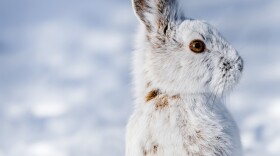Sometimes the Dog Knows Better
By Marta Meengs
It’s time for Field Notes, brought to you by the Montana Natural History Center.
When I first moved to Missoula from Alaska, many years ago, I was excited by the prospect of learning all about the new native plants and animals. One vivid memory I have of those new arrival days of investigation was on a hike with my Alaskan husky. We were strolling down the well-loved street of Missoula Avenue, close to my house, and came upon a small tree with a lot of dark purple berries. I paused and began to study the details of this tree, noticing that it had long, well-spaced thorns and interesting bark patterns. My eyes slowly followed the tree down to the base when I saw that my dog was carefully pulling the berries right off the branches and swallowing them down.
My first thought was that I had a certain trust in my husky's wilder instincts. Both her doggie parents had raced in the Iditarod and I respected the instincts she inherited from her hardy ancestors. If she thought these berries were edible, by gosh, and tasty even, perhaps they were! Then my caution set in and I worried that maybe they could be poisonous. I pulled her away but she had already ingested quite a few.
As soon as I returned home, I grabbed my Montana native plant field guide and identified the tree as a Douglas’s hawthorn. Hawthorns produce dense clusters of white flowers that bloom in May and June, and dark purple berries that ripen in late July and early August. My husky was indeed right about the berries. They are quite edible and enjoyed by both humans and other creatures such as bears, many species of birds, coyotes, squirrels, and foxes. On my next walk by this tree, I popped a few berries in my mouth and discovered that they had a pleasant flavor—a slight tang and mild sweetness.
This was my first berry-eating experience in Montana, but my husky and I soon had another one while hiking in the Rattlesnake Wilderness with an out-of-town friend one fall. The three of us came upon some bushes covered with white snowberries, and my friend was quite curious about this shrub. The tight cluster of beautiful white berries are quite unusual-looking as far as berries go. I told him the correct name and then remembered (or I thought I remembered) reading that Indigenous people sometimes ate them. He and I then impulsively picked a couple and popped them into our mouths to see what they tasted like. I should mention that my husky was not at all interested in these berries and really, I can say they tasted quite awful.
After returning home, I did some more investigation and found that these snowberries contain a compound called “saponin” and, if eaten, can make humans sick—but, thank goodness, usually only in larger quantities. Perhaps impulsively popping berries in my mouth is not such a good idea. I found out that bears and some birds will eat snowberries but that, maybe because of their lack of flavor, they are their last choice. But even though snowberries are not a good choice for humans to eat, they still offer some of the most beautiful late-fall color the forest has to offer. The sprinkle of bright white stands out throughout the forest in contrast to all the grays and browns.
Since then, I’ve had many berry-eating memories with my husky by my side. Each summer we had what could be described as a competition for the biggest, most ripe huckleberries. She definitely knew which ones were the tastiest and went for the juiciest ones on the bush. Perhaps she knew best about how delicious these berries were when eaten right off the bush. For many years she remained my trusted guide in berry picking and my overall favorite hiking companion.
Today’s Field Note was written in the Field Notes Writing Workshop at the Montana Natural History Center. This is Marta Meengs for Field Notes, brought to you by the Montana Natural History Center, providing natural history education for schools and the public throughout Montana. To find out about upcoming events and programs at the Center, call 406.327.0405, or visit our website at MontanaNaturalist.org.





